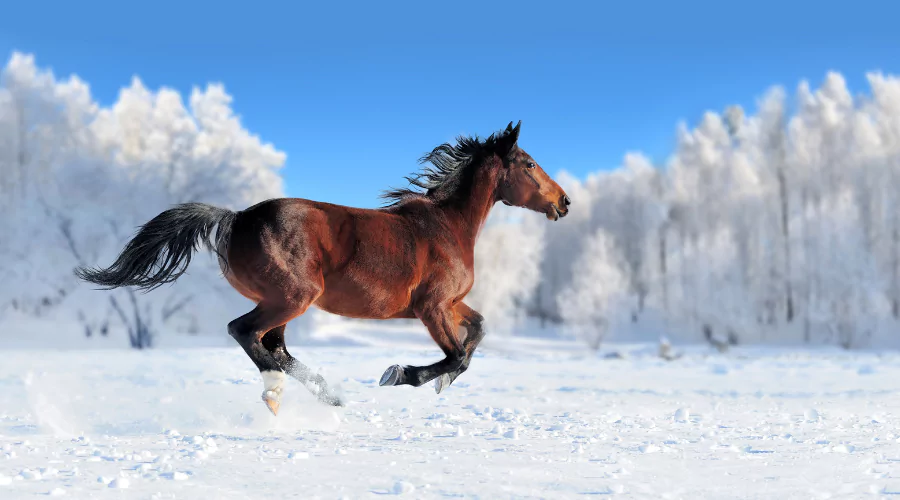With its large and diverse environment, Russia has a rich history and culture, reflected in its great equestrian tradition. When one thinks about Russian horses, thoughts of power, resilience, and elegance emerge, firmly engrained in the region’s breeds. From the icy Siberian tundra to the vast steppe, the necessity for durable and flexible horses capable of flourishing in harsh environments has affected the history of horse breeds in Russia.
History of Russian Horse Breeds
The history of Russian horse breeds is as ancient as the country itself, intermingled with stories of rulers and simple people alike. The Akhal-Teke, one of the oldest surviving horse breeds, is well-known for its metallic shine and power. These horses, bred in Turkmenistan’s blistering deserts, were highly valued by Russian nobles for their speed and endurance.
Moving forward in time, the hefty and strong Budenny appears, a breed developed by combining Don horses with Thoroughbreds to produce an all-purpose cavalry horse during the early Soviet era. These breeds, together with the hardy Russian Trotter and the sturdy Yakutian horse, which adapted to live in Siberia’s harsh temperatures, demonstrate the variety and persistence of Russian equines from the Tsarist period to the present.
Aside from being a source of national pride, Russian horses have faithfully served their human counterparts in various roles. During WWII, the Budenny breed, known for its endurance and speed, was crucial in transporting soldiers and supplies into combat. They are still popular sports horses, doing well in racing and show jumping competitions.
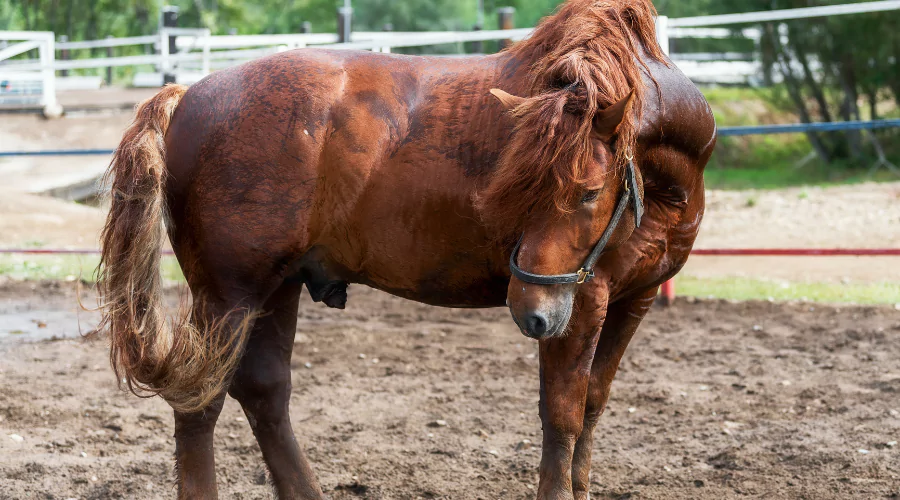
The Soviet Heavy Draft Horse
The Soviet Heavy Draft Horse is one of Russia’s most notable horse breeds, the product of meticulous selection and breeding in the early Soviet period. These horses, known for their amazing power and endurance, were designed to satisfy the agricultural needs of a two-continent society. With a muscular frame, a calm personality, and a strong work ethic, the Soviet Heavy Draft Horse has played an important part in rural agricultural communities throughout Russia.
The Diversity of Russian Horses
However, the Soviet Heavy Draft is not Russia’s sole equestrian treasure. The wide areas of Russia are home to various horse breeds, each with distinct traits and histories that reflect the varied climates and civilizations from which they have evolved. These breeds vary from the quick and graceful Orlov Trotter, famed for its speed and agility, to the sturdy Bashkir, known for its ability to tolerate frigid conditions with a coat capable of enduring the hardest Siberian winter.
As you dive further into Russian horses, each paragraph may explore various breeds, explaining their origins, traits, and significance in Russian history and culture. Remember to organically include the supporting keywords “Russian horses,” “Soviet heavy draft horse,” and “Russian horses” in your writing as you elaborate on each subject.
Top 10 Russian Horse Breeds
As we approach the compilation of the top 10 Russian horse breeds, we must recognize the breadth and depth of equine variety that this nation hosts. Following are the top 10 breeds of horse Russia holds.
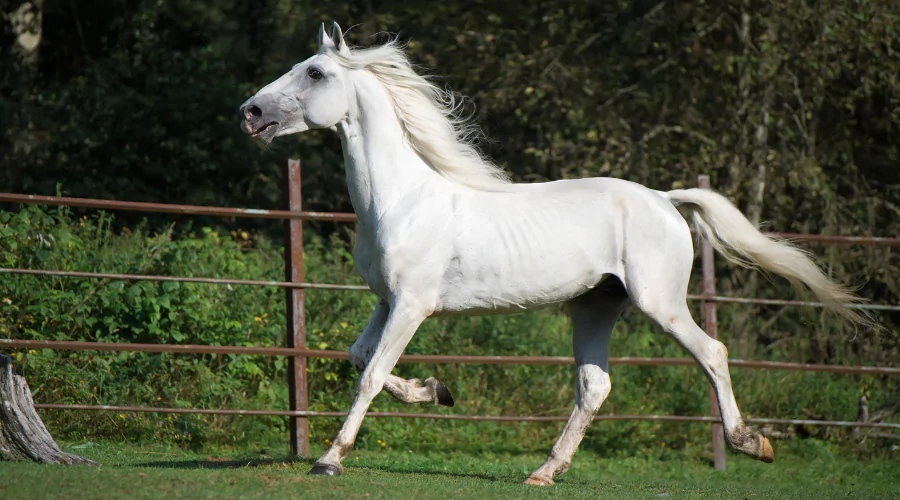
The Orlov Trotter: Nobility on Hooves
Count Alexei Orlov established the Orlov Trotter, a breed synonymous with Russian equestrian royalty, in the late 18th century. This breed was known for its speed, stamina, and characteristic rapid trot, which helped shape current trotting competitions. The Orlov Trotter is a remarkable mix of beauty and power, with a lengthy stride that has made it a perennial favorite in Russian harness racing and beyond. It has also influenced the evolution of well-known Russian breeds, like the Don and Russian Trotter.
The Orlov Trotter is admired for its track prowess and amazing physical characteristics. Standing at an average height of 15 to 16 hands, these horses have a statuesque physique with a well-muscled yet elegant body. They have a wide chest and a robust back, contributing to their impressive trotting abilities. Their heads are well proportioned, with a straight profile and expressive eyes representing the breed’s intelligence and alertness. The Orlov Trotter’s coat comes in various hues, including gray, which is the most popular and adds to the breed’s regal aspect. Their thick, flowing mane and tail enhance their royal appearance, distinguishing them as a breed of both beauty and practicality.

The Bashkir: The Siberian Survivor
The Bashkir horse, native to the Ural Mountains and adapted to cold weather, is praised for its toughness and ability to flourish in hard conditions. The Bashkir, distinguished by its curly coat that offers protection against extreme cold, is a hardworking, adaptable breed used in both riding and agricultural labor.
Despite their rough appearance, Bashkir horses are quite tiny, measuring between 13 and 14 hands tall, which is ideal for the rocky terrains from whence they originated. They have a compact and muscular build that demonstrates their strength and endurance. Other distinguishing characteristics include their pleasant demeanor, which makes them ideal for equestrian therapy and beginning riders. Furthermore, the Bashkir is known for its distinct metabolic adaptation to extreme cold, which not only influences its lower dietary requirements compared to other breeds but also demonstrates its extraordinary ability to survive and work efficiently in the most hostile environments.

The Don Horse: Cavalry’s Companion
The Don Horse, which originated in the steppes near the Don River, is a versatile breed that served as the foundation of the Cossack cavalry. These horses are noted for their speed and have outstanding endurance and agility. Warriors have long respected them for their courage and composure in combat.
The Don Horse normally has a robust, slender frame and stands between 15 and 16 hands tall, giving it a commanding presence in war and other situations. Its muscular legs and well-defined withers indicate a superb ability for long-distance running, making it important to the Cossacks. The breed’s smooth coat, commonly bay, black, or chestnut, adds to its remarkable look. These horses are not only appreciated for their physical attributes, but also for their lively but controlled disposition. Because of its distinct characteristics, the Don Horse is equally suited to equestrian sports, leisure riding, and modern-day historical reenactments.

The Altai Horse: The Mountain Trekker
Another breed capable of enduring harsh weather conditions is the Altai Horse, which may be found in Siberia’s Altai area. The Altai is a tiny but strong breed recognized for its sure-footedness and toughness, making it a popular saddle and pack horse, particularly in hilly terrains.
The Altai Horse is between 13 and 14 hands tall and has a powerful and well-balanced body structure for crossing Siberia’s difficult terrain. Their short, muscular legs can carry huge loads over long distances, and their broad hooves provide stability on uneven and rocky terrain. The Altai Horse’s coat is thick, enabling it to survive cold temperatures. In disposition, these horses are recognized for their obedience and dependability, making them highly appreciated by nomadic peoples who rely on them for survival. The Altai Horse’s extraordinary adaptation to scant pasture and resilience to local illnesses make it an essential component of the pastoral economy of its home area.

The Russian Trotter: A Racing Legacy
The Russian Trotter was developed by crossing the Orlov Trotter with American Standardbred horses to create a quicker trotting horse for racing. Despite its racing beginnings, it is now popular as a riding horse because of its gentle attitude and adaptability.
The Russian Trotter is an excellent option for competitive and pleasure riders. On average, these horses stand 15 to 16 hands tall, echoing the Orlov’s height and adding to their muscular, athletic aspect. Their body is powerful but streamlined, making them ideal for the fast trotting necessary on racing circuits. They not only have the speed acquired from their American forefathers, but they also have the intellect and beautiful movement associated with their Orlov heritage. The coat hues vary from bay, chestnut, and black, highlighting their slim lines.
While the Russian Trotter exudes excitement and vitality on the track or in the field, they are also noted for their calm and cooperative disposition, making them perfect partners for riders of all ability levels.
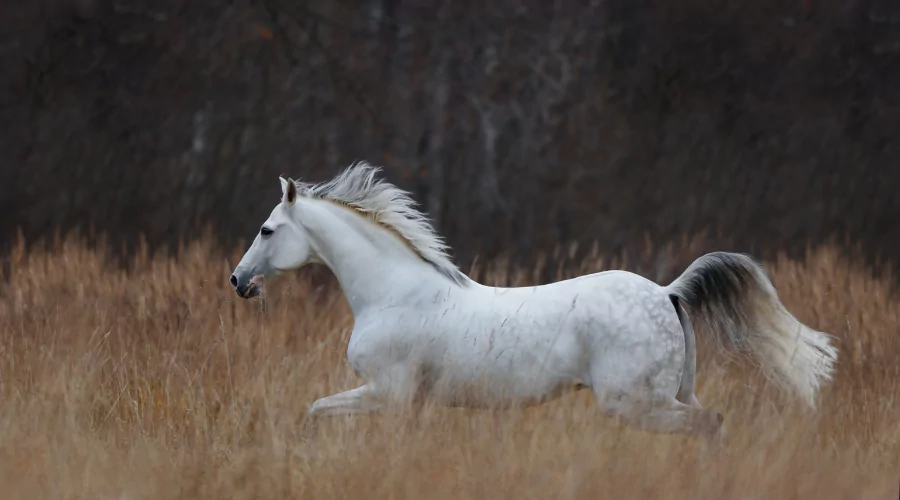
The Tersk Horse: Beauty and Agility
Tersk horses are known for their delicate shape and outstanding beauty. This breed was developed at the Tersk Stud and is a cross of Arabian and Don lineages, producing a horse with elegance, agility, and endurance.
With an average height of 14 to 15 hands, the Tersk Horse displays grace while maintaining power and ability. Its Arabian origin is obvious in its dished face and high tail carriage, while the Don Horse’s impact is noticeable in its strength and endurance. The Tersk’s exquisite coat, often seen in grey or chestnut, improves its aristocratic aspect and emphasizes its standing as a horse of distinction. Furthermore, the Tersk is known for its rapid learning ability and friendly disposition, which, along with its agility, make it a good option for dressage and show jumping, appealing the breed to equestrian fans throughout the globe.

The Yakutian Horse: The Siberian Endurer
The Yakutian Horse, adapted to live in the harsh cold of Siberia, is a tiny but muscular breed with a thick coat and the remarkable ability to search for food through snow. Their perseverance is only equaled by their strength and ability to labor in subzero conditions.
The Yakutian Horse stands at a relatively short 12 to 14 hands, giving it a low center of gravity essential for stability in its cold and ice environment. This tiny stature hides the breed’s incredible strength and endurance, traits developed over millennia of adaptation to some of the hardest settings on the planet. Along with their size, these horses have thick skin and a rich layer of fat, which protects against the cold. Their hooves are large and spherical, preventing them from sinking into snow. Along with their long, thick mane and tail, this provides further protection against chilly weather.
These adaptive characteristics allow the Yakutian Horse to flourish in harsh environments and make it a significant resource for indigenous populations who rely on it for transportation and agriculture.
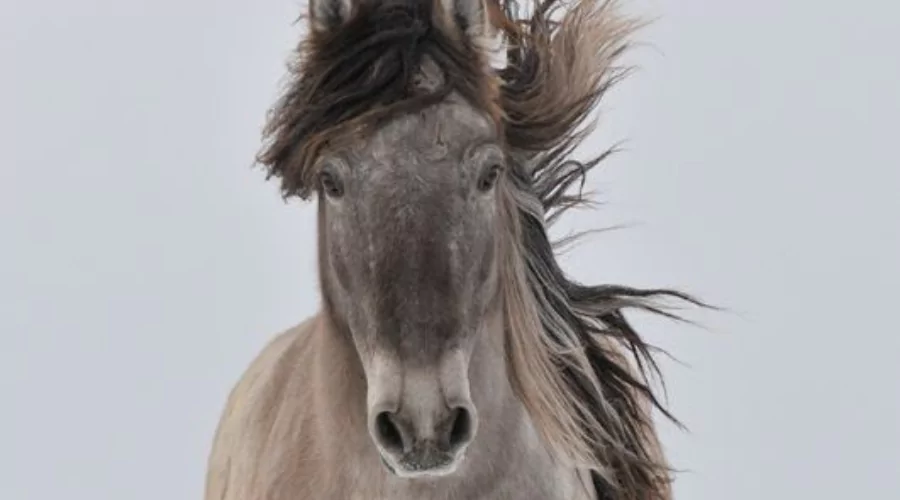
The Mezen Horse: The Northern Hardy
The Mezen Horse, originating in the Mezen River region, is another northern breed famed for its hardiness. It has a strong frame and a calm demeanor and is suitable for general riding and mild draft duties.
Unlike other bigger breeds, the Mezen Horse stands at an average height of 13 to 15 hands, which suits it well in northern Russia’s deep woods and harsh terrain. It has a compact and powerful build that is ideally adapted to the hard labor found in its native location. The Mezen Horse has a strong, waterproof coat that is generally bay or gray, which allows it to withstand the cold, wet temperatures it is used to. Furthermore, this breed is known for its longevity, soundness, and genetic endurance, supporting its position as a dependable worker. Despite its utilitarian beginnings, the Mezen Horse is noted for its gentle and docile nature, which appeals to riders and farmers.

The Vladimir Heavy Draft: The Resolute Worker
The Vladimir Heavy Draft is known for its tremendous agricultural and heavy draft labor contributions. This breed originated in the Vladimir area and combines the power and gentle demeanor of the Soviet Heavy Draft with its traits.
The Vladimir Heavy Draft, which normally stands between 15 and 16 hands, symbolizes strength and perseverance. Its enormous frame supports a strong physique required for carrying big loads, making it the preferred breed for difficult agricultural labor. This breed’s coat, typically seen in roan, bay, and chestnut colors, is thick and sturdy, giving enough protection against the severe weather conditions endemic in its origin. The breed’s large chest and well-sprung ribs stand out, contributing to its exceptional lung capacity and endurance. Despite its size and power, the Vladimir Heavy Draft is noted for its calm demeanor and enthusiasm to work, making it a strong worker and a pleasant and dependable partner for the jobs for which it was bred.

The Russian Riding Horse: Elegance in Motion
Finally, the Russian Riding Horse mixes Thoroughbred genetics with local Russian breeds to provide a versatile riding horse with excellent jumping ability and speed. This breed has gained popularity in equestrian sports because of its athleticism and grace.
As we learn more about Russia’s equestrian culture, we see how these breeds demonstrate the adaptability and heartiness necessary to live in the different and sometimes hard Russian environments. They reflect the country’s rich history, displaying how Imperial Russia, the Soviet period, and current times have molded these lovely animals.
Frequently Asked Questions About Russian Horse Breeds
What features distinguish Russian horse breeds from others?
Russian horse breeds are well-known for their outstanding endurance, resistance to harsh temperatures, and flexibility. Many of these varieties, such as the Yakutian and Mezen, have evolved special characteristics that enable them to flourish in the harsh Siberian environment.
Are Russian Heavy Drafts suitable for beginners?
Despite its great size, the Vladimir Heavy Draft is recognized for its gentle and calm temperament. It is an appropriate option for novices capable of managing a tremendous height and power horse, particularly when supervised or trained properly.
Can Tersk horses be used for general riding, or are they exclusively show horses?
The Tersk horse, having Arabian and Don lineage, is elegant and graceful, making it an excellent show horse. However, they are clever, kind, and fast learners, suitable for ordinary riding and endurance sports.
How do Yakutian Horses survive the intense cold?
Yakutian Horses have developed a thick, insulating coat, a rich fat coating, and large, spherical hooves that function as snowshoes in the harsh Siberian winter. Their capacity to forage in the snow also helps them survive.
What kind of equestrian sports are Russian Riding Horses used in?
The Russian Riding Horse, with Thoroughbred and local Russian bloodlines, excels in equestrian sports, notably show jumping and eventing, because of its excellent jumping ability, speed, and general agility.
Conclusion
In conclusion, Russia’s horse breeds reflect the country’s varied geography and complicated history. The extraordinary adaptations of the Yakutian Horse and the stubborn power of the Vladimir Heavy Draft reveal the equines’ amazing variety and persistence. Each breed serves a functional purpose while representing the Russian people’s cultural history and passion. Whether surviving the Siberian cold or displaying beauty in competitive sports, Russian horses remain vital to the country’s character and substantially contribute to the worldwide equestrian community.
You May Also Like:
The Magnificent Family of Mexican Horse Breeds:
Top 6 Big Horse Breeds
Best 6 North American Horse Breeds
The Rich Heritage of Irish Horse Breeds
Top 10 Rarest French Horse Breeds
